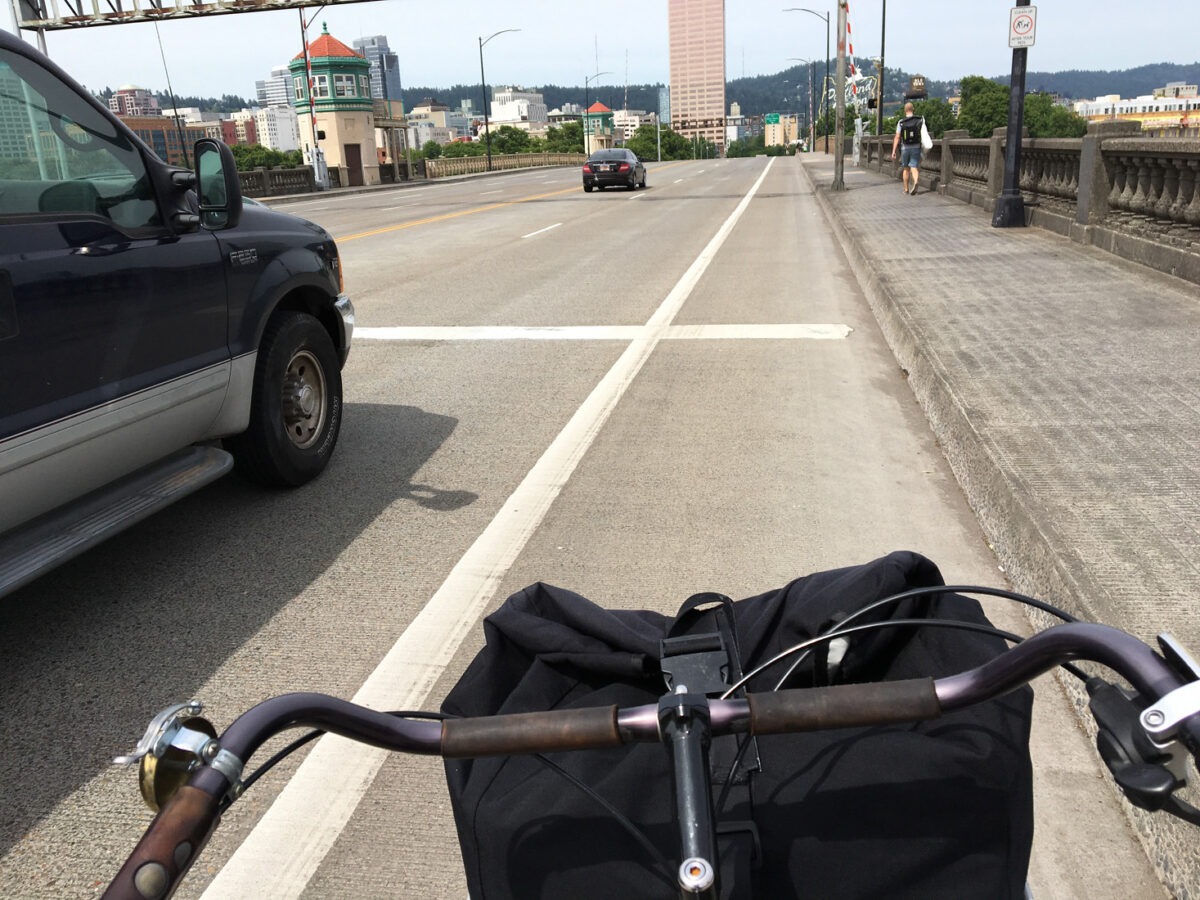
(Photo: J. Maus/BikePortland)
“Advocates… let us know how important it is to do something more soon to separate bicyclists from traffic on the bridge.”
— Mike Pullen, Multnomah County
If you attended the annual Alice Awards fundraiser hosted by The Street Trust last month, you heard the event’s emcee, Multnomah County Commissioner Jessica Vega Pederson, break some good news: When the Burnside Bridge fully re-opens after a maintenance project wraps up later this year its bike lanes will be wider and be separated with plastic wands.
“Three months ago, The Street Trust and other advocates learned that Multnomah County did not intend to provide physical protection for bike lanes until the Burnside Bridge is replaced,” the organization shared on their website this week. “The Street Trust banded together with Bike Loud and Better Block PDX to demand protected bike lanes now.”
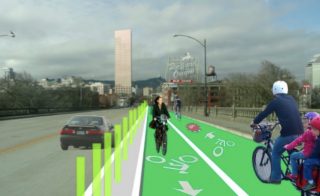
For years, Portlanders have pushed to have more protected* cycling space on the Burnside Bridge. In 2012 I joined a team of planners to propose a two-way protected lane on the bridge for bicycle users. In 2015, when a man lost control of his SUV and killed someone (and seriously injured another person) who was walking on the bridge sidewalk, I said “enough is enough” and called on the City and County to do something. After that tragedy we shared possible design changes that would create space for a wider, protected bike lane. In 2016, Better Block planned a demonstration project that would have included physically protected bike lanes on the bridge. That demo never happened, but support for the concept never waned.
Now, with a County maintenance project on the bridge due to end in November and with the City of Portland’s Central City in Motion (CCIM) project all queued up, it appears that
a breakthrough has finally occurred.
This outcome was never guaranteed. At least not for another 10 years. It happened because Portland advocates stepped up to push the issue forward.
Advertisement
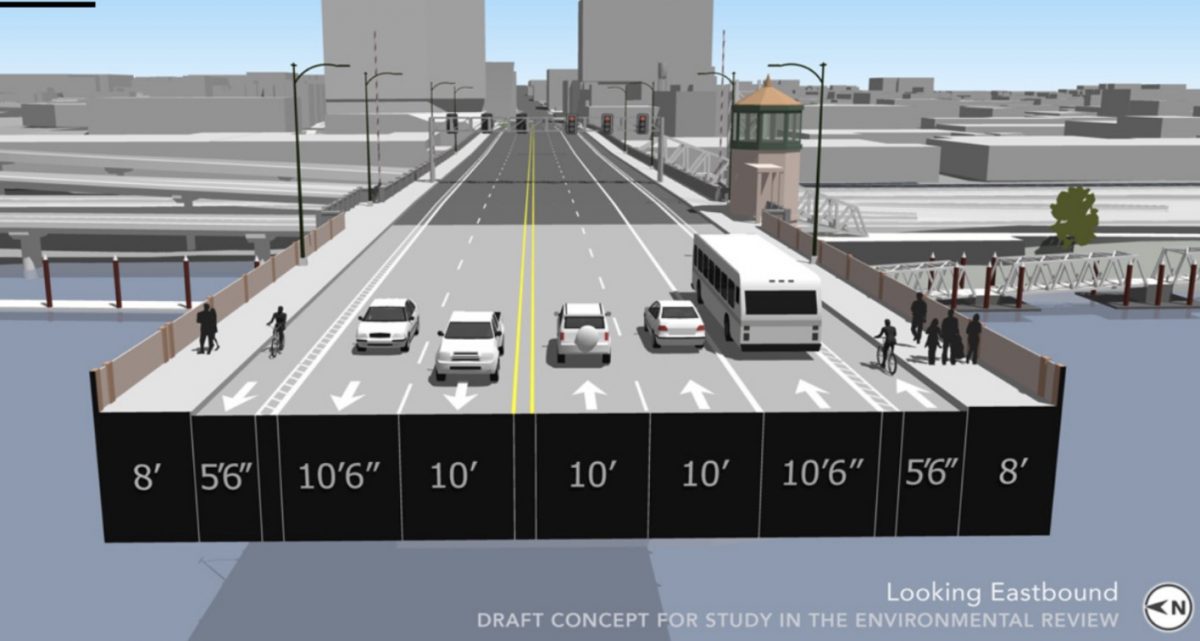
(Graphic: Multnomah County)
Multnomah County plans to replace this bridge with a more earthquake-ready version several years from now. That new bridge will almost certainly come with serious bike lane protection such as a concrete jersey barrier. But what about the period between now and whenever that bridge is built?
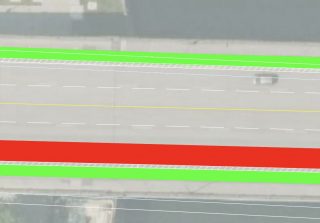
The County owns and manages the bridge, but they work with PBOT to decide how the lanes are striped. In this case the County worked with PBOT’s CCIM project team to narrow existing lanes in order to create two-foot wide bike lane buffer zones between bicycle and car users. PBOT plans (PDF) show only a painted buffer and no physical separators of any kind. Even the PBOT project website says this new striping plan offers only, “the possibility of providing protected bike lanes.”
When The Street Trust Executive Director Jillian Detweiler started to sniff around this situation a few months, she sensed resistance to protected bike lanes from County project staff. One reason the County might have been reluctant is because their sweepers can’t fit into narrow bike lanes that have physical separation. Not satisfied with excuses she was hearing, Detweiler reached out to other advocates and set up meetings with the County and with the City of Portland.
According to Detweiler, County Transportation Director Ian Cannon wasn’t willing to add physical protection and tried to persuade the advocates to wait for the new bridge. That’s when she contacted Commissioner Vega Pederson and convinced her to support the proposal.
Multnomah County spokesperson Mike Pullen confirmed with us today that the Commissioner made her support of the protected lanes known and that the advocates, “Let us know how important it is to bicyclists to do something more soon to separate bicyclists from traffic on the bridge.”
Pullen now says white “candlestick” delineator wands will be added in the new buffer zone. “While these won’t stop a motor vehicle, they do give drivers a clearer view of the buffer zone, especially at night and in bad weather,” he said.
The wands will be installed in the next two months. And if you’re concerned about debris in the bike lanes, Pullen said they plan to draft a maintenance agreement with PBOT (who just added another tiny sweeper to their fleet). We’ve asked PBOT for an update on their CCIM bus lane/bike lane project on the bridge and will update this post when we hear back.
For now, I want to say “Thank you!” to Jillian, Emily Guise from Bike Loud, and Ryan Hashagen from Better Block. Your diplomacy skills and passion for safer bikeways really made a difference!
(*NOTE, 10/17 at 8:10 am: There’s an ongoing discussion about whether or not plastic wands constitute real “protection”. Some readers have questioned my use of that word and feel it gives too much value to what are nothing more than weak pieces of plastic that don’t provide quality, physical protection from multi-ton vehicles. I’m still thinking about the best way to describe our various types of bike lanes and the amount of true “protection” they provide. I take word choices very seriously and will continue to evolve my thinking on this specific usage. Thanks for the feedback.)
— Jonathan Maus: (503) 706-8804, @jonathan_maus on Twitter and jonathan@bikeportland.org
— Get our headlines delivered to your inbox.
— Support this independent community media outlet with a one-time contribution or monthly subscription.

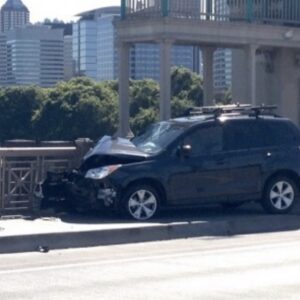

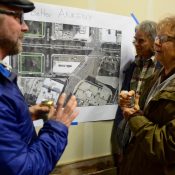
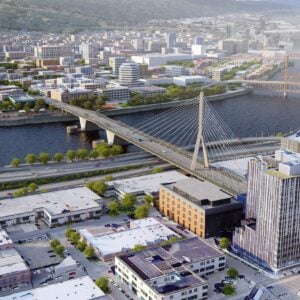
Thanks for reading.
BikePortland has served this community with independent community journalism since 2005. We rely on subscriptions from readers like you to survive. Your financial support is vital in keeping this valuable resource alive and well.
Please subscribe today to strengthen and expand our work.
THANK YOU!!!!! As an everyday Burnside rider I am sooo thrilled to see this happening.
On the way in this morning I saw that they have started marking the lanes for stripe-ing and wanding. After years of riding a semi dangerous bridge, and now years of construction, I am pleased to see a light at the end of the bridge.
Hell yeah! Thank you JVP! Great job advocates!
Here’s hoping this leads to PBOT warming up to separated facilities on East and West Burnside next.
I got so excited when I read the headline and then so disappointed when I saw that plastic wands now count as “protection”. While this is better than paint only, it is still just a buffer and does almost nothing to make me (a fit rider in my late 30s) feel safer; how on earth is this supposed to make riding more palatable to younger/older/newer riders? Why they can’t pop some jersey barriers on the bridge and then move them to the next spot/project when they rebuild the bridge is beyond me. (I’m sure the engineers will pop in and tell me why. Thanks in advance I think.) While I celebrate all that advocates have and are doing, I hate it that we are celebrating crumbs and I can’t wait to pop a cork for some beautiful, functional, safe bike infrastructure.
The various forms of the word “protect” were used 16 times in this article. I wish we would have said what it is- visually separated. Separate was used 6 times.
Julie,
I totally hear you and you can rest assured that this website does not consider plastic wands adequate or ideal “protection”. They’re an interim step IMO. Use of the word “protection” is really more for lack of a better one.
As for why they can’t plop down jersey barriers. In this case, there might be a few reasons: 1) Concrete barriers are super heavy and some bridge owners freak out about added weight on spans. 2) County says when you consider “shy distance” away from a concrete wall, there’s “not enough room”. 3) The County/City/advisory committees are too afraid to limit driving capacity on the bridge so they are giving way too much room for cars and that’s why we don’t have room for a more substantial wall.
So they did “plop down” concrete and plastic jersey barriers during all the recent burnside construction. The middle/lift spans of the bridge were fitted with steel guardrails attached to bolted-down wood posts. I’m not sure why that approach can’t be put into use on both sides of the bridge? I guarantee you we’d start seeing a lot of cars with “Burnside scars” on the sides, but that’s a lot better than anyone getting hit.
Yeah, I suppose the weight of the concrete and the lack of willpower are real things – not sure which one is easier to change. It is funny that sometimes half block re-routes due to construction cause those orange plastic barriers jersey barriers (not sure if they are still called that if they are plastic) to be installed and we riders get a tiny moment of (more) real protection before being thrown back into the world of paint only.
I’m with some other folks who would like to see the word “protected” only be used when there is substantial physical protection in place. I wonder if something like “delineated”, while obviously super clunky, is better than “separated” which sounds too like it is apart from, rather than a part of, the road. Or maybe a second word is needed: visually separated vs. physically separated?
JM: “Use of the word ‘protection’…”
I’ve really respected your use — and focus on — language over the years. It’s so important to hold others to the fire (police, DOTs etc). My two cents: I think you are taking the easy way out here and giving this facility improvement more positive-ness than it deserves by using “protection.
For what it’s worth, I think “separation” or “visual separation” would be better.
Hi everyone,
I really appreciate the critiques and insight of my use of the word “protection”. I am thinking about this and will definitely take your concerns into mind now (with some possible edits to this story) and in the future. Word stuff is tricky and it requires thought to balance activism with journalism and basic writing effectiveness. I’ll play with some different words and continue to refine things. Please continue to let me know how you feel about the words I choose. Thank you!
how about:
vertically delineated bikes lanes
Was about to say the same thing. This blog constantly disappoints when using the term “protected” instead of the proper “separated”. Especially, as Jonathan says, he agrees they’re not considered “protection”.
I can understand how a full barrier probably has to be engineered into the new bridge because of weight, but they could (and should) do better than this. Jersey barriers for at least the final few feet at the ends of each side and then interspersed along it until the lift section. Even on the lift ramps perhaps a lightweight plastic full barrier could work. At least then drivers could see some consequence to not staying in they’re lane and give a little more true “protection”.
Would these be like the plastic wands installed to separate the bike line on the west exit from Broadway bridge down to Lovejoy? The ones that were knocked down so often by cars that PBOT gave up replacing them? If so, not a fan.
I hoping they don’t build a new bridge. They can retrofit the current one and designate one lane each way for each mode of traffic. None of the proposed designs are best-practice.
Seems like replacing a row of 4000lb vehicles with a row of 2000lb barriers would make it easier to retrofit.
Thanks for covering this, Jonathan!
While I am disappointed that we couldn’t get more substantial protection on the bridge (I’m a regular rider), there were two big issues that prevented it:
The County requires 9 feet minimum for any physically protected bike lanes (like jersey barriers), to be able to get their cranes in for maintenance on the underside of the bridge. This was non-negotiable.
ODOT was administering the federal grant for this bridge project, and lane striping plan was already in place. Jillian, Ryan, and I asked for a west-bound lane to be repurposed into wider bike lanes with physical protection, but this would have required re-negotiation at a late stage between ODOT, the feds, the County, and PBOT, so it didn’t happen.
While I wish we could have gotten more protection, I am glad that something is being added to the lanes to mark the space for bikes better. Big thanks to Commissioner Vega Pederson for her support and to my fellow advocates Jillian and Ryan for their patience and persistence.
Thank you, as always, for your advocacy Emily (and others).
I can’t get excited about plastic.
Thanks Jillian for moving the needle forward!!!
Thank you to Commissioner JVP to hearing community concerns and being willing to advance the requests! And, and thank you to Jillian, Ryan, and Emily & Bikeloud for pursuing this particular improvement. I am excited to see the improvements and hope that the next time around physical separation is part of the outcome.
Hats off to the county and their transportation planners/designers
Can we get that tiny sweeper up on SW Capitol Hwy? The new and gorgeous separated (not protected) bike lanes have already filled up with wet and slippery leaves and pine needles (lots of trees in SW Portland – so lucky to have them). In some places the buffer is probably wide enough for a regular sweeper. Would be interesting if you could write a post about street sweeping and how these new separated lanes are designed to work with sweepers, or not. In many places it seems like an afterthought, like much cycling infrastructure, unfortunately.
Unfortunately we’ve entered the time of year where all the bike lanes fill up with detrius because we don’t create a large enough footprint to clear them with friction as the car lanes do. They will sweep them but I’ve found, over the years, that they wait for the largest drops to happen first. Expect to see the sweepers out in a few weeks.
FYI: I just added this note to the story:
(*NOTE, 10/17 at 8:10 am: There’s an ongoing discussion about whether or not plastic wands constitute real “protection”. Some readers have questioned my use of that word and feel it gives too much value to what are nothing more than weak pieces of plastic that don’t provide quality, physical protection from multi-ton vehicles. I’m still thinking about the best way to describe our various types of bike lanes and the amount of true “protection” they provide. I take word choices very seriously and will continue to evolve my thinking on this specific usage. Thanks for the feedback.)
Thank you Jonathan!
Hello, I see that it seems that everyone that is vocal want to cut the traffic lanes for cars, and I am sure I will be flamed here due to my disagreement on how much is too much? Look at 102nd between Halsey and Sandy Blvd. I n my opinion that is TOO much. Remove two traffic lanes to accommodate very little bike traffic. At rush hours, (mostly northbound I 205 into Washington) 102nd would be backed up to Prescott st and it could take up to an hour to move that very little distance, NOW 102nd is backed up to Gliesen St as a single lane in the northbound direction, that is an additional 7 blocks (and we ain’t talkin tiny blocks). Yet I travel this multiple times on a daily basis and see maybe one or two bikes the entire time. While it is possible that the bike riders have my schedule and simply don’t ride when I am there it is unlikely. I understand that bike riders want to be safe, and also the bike trend is to get rid of cars and have everyone ride bikes. Some simply cannot, I also pay taxes (lots of them it seems) Im not a 1%’er and I just find that there is a very vocal group that seems to only advocate for themselves not for the public at large. Why isn’t there a compromise you wish to take a lane for bike traffic put the jersey rails on the side to protect the riders, GREAT, however do you really need to take several lanes, for this? or is it a statement by the PBOT to say ” yes you pay taxes but the roads aren’t for you” One of the traffic lanes should be reinstated on 102nd to ease carbon emission for those that choose to drive. You have choice to ride a bike if you choose, why is the biking community seemingly hell bent on taking others rights away to the benefit of the very few. Respectfully Ralf
That’s like saying that just because there isn’t constant traffic on whatever stretch of street, that vehicles shouldn’t have lanes!
Sometimes Scholls Ferry doesn’t have a lot of traffic, does that mean we can take out a car lane in each direction since they clearly aren’t using it all the time? Or we can take out the center turn lanes because they aren’t fully occupied at all times?
It’s a false equivalency. Just because you don’t see anyone at a particular point in time doesn’t mean no one uses it. You don’t know the level of usage unless you are spending 24 hours a day, every day, at that location counting.
Thank you for the reply, in my comment, i believe that the point I was making was “excess” taking two lanes out when I believe that removing one lane would have been sufficient and I don’t think it is a “false equivalency” I live in this area and have for almost 16 years, over all that time I think the bike traffic is about the same maybe a small increase. I just think it was a bit overdone and could have been adequate to just take out one lane in a compromise for both car drivers and bike drivers. Your completely right I don’t know the exact amount of bike traffic however I do have eyes and do travel 102nd at all different times of the day from very early morning to very late at night. If I remember the “rubber hoses” that they put across the street to measure bike and car traffic wasn’t there for more than a few days, maybe a week, that doesn’t seem like very much time to do a traffic study , just my humble opinion. Respectfully Ralf
Sandy blvd to prescott=1400′ along 102nd
Sandy blvd to Halsey=9000′ along 102nd
How does halving the capacity increase the volume 6 times? I’d say that if 102nd is now backed up all the way to Glisan, then things are working. Now the drivers trying to bypass 205 can just get on at Glisan instead of cutting through neighborhoods and using 102nd to get on 205 at Sandy.
Back to slightly more of the point of this article, that stretch of 102nd should have protected lanes, too.
Thank you for the response, I’m not sure the volume is increased 6 times, (you’r much better at math than me) however perception is reality and my perception. I also agree on the protected bike lane, having four lanes (two in each direction) and doing what is proposed for the bridge of narrowing up or maybe even removing parking on one side or the other would have provided for a two way bike lane with jersey barriers . My whole point is compromise for both segments of the population (bike and car) to allow for better traffic flow. Having the PBOT rep simply say “get used to it” instead of looking at viable alternatives such as different times of the day maybe the center lane change direction (don’t yell to loud ok:)) or the bike lane all on one side of the street instead of changing sides with what appears to be no rhyme or reason. again my humble opinion. Respectfully Ralf
Ralf, it’s not about bikes vs cars – it’s about creating a safe space for everyone. Four-lane neighborhood highways are unsafe for everyone, though you probably don’t have that impression if you’re in a car all the time AND you’ve been lucky enough to avoid a collision. Four-lane streets encourage speeding. In fact, on SW Capitol Hwy, which used to be a four-lane neighborhood highway, over 60% of cars and trucks used to exceed the speed limit! Now that it’s mostly two lanes, almost every car is driving at or below the speed limit, making the street much safer for *everyone* to use. Transportation is about more than you being able to get where you want to go quickly – it’s also about safety.
There is absolutely ZERO need for 2 lanes in the westbound direction. We’ve had over 2 years of maintenance and I’ve never once seen any traffic backed up headed in the westbound lanes.
The plastic wands seem to be one of PBOT’s preferred tools recently. I suppose they *might* be slightly effective in keeping cars and trucks out of bike lanes, but I really don’t like the way they add a lot of visual clutter to the streetscape. After a year or so the wands are scuffed up and damaged and look pretty junky. For example: https://www.google.com/maps/@45.569875,-122.6772449,3a,75y,87.38h,90.29t/data=!3m6!1e1!3m4!1sxpKhzwZJBqfP5lMZVLOjrg!2e0!7i16384!8i8192
Also, they have mostly been applied to regular bike lanes which makes it a lot harder for bike riders to pass bike riders. From the look of the drawings above it appears that this will be a problem on the Burnside Bridge.
Advocates should convince the city to start handing out tickets for failure to maintain a lane.
It’s infuriating. IME, most drivers are good about giving space, but It’s such second nature for so many of them to blithely ignore the lines on the road, that the one case (as well demonstrated by this video) where the driver hasn’t noticed you, is the one, where he’s going to hit you.
Thanks Jonathan for being open to feedback on using the word “protected” to describe bike lanes with plastic wands. While it’s tough to find alternatives, I would like to add a strong vote for NOT using “protected”. Something in the “separated” vernacular probably works.
Better to have the plastic wands than not, so perhaps these will aid in prevention, but certainly not protection when [not if] vehicles cross them in a distraction or crash scenario. Definitely like them for dark and rainy conditions.
Someone mentioned the use of those plastic jersey barriers that are often used at construction sites. They are designed to be filled with water – in fact, they are often empty – but either way, they provide a false sense of security as they are not anchored. Any car crashing into one will push it violently into the walk/bike way. I avoid them unless there is no traffic … or a crawling traffic jam.
It is simply getting more difficult these days to avoid placing oneself in harm’s way.
the ones by moda center worry me its way tight in the bike lane and right hook zone 🙁
Protection from responsible drivers, but not road-raged lunatics? Last weekend I was able to see a real protected bike lane in Eugene. Check it out. https://vimeo.com/349131750
That’s terrific – thanks for sharing. But (and there’s always a butt) it looks like that’s a pretty special piece of real estate, with plenty of room to build alongside a road – possibly in an old RR ROW? Still, nice work by the city of Eugene.
This endless argument about what constitutes “protection” for a bike lane is pretty tedious. Nothing short of a jersey barrier will actually stop a moving car from driving into a bike lane if the driver is being completely crazy and careless. A car can easily go through plastic wands, sure, but they can also easily hop a curb, even a high one (that’s what killed the pedestrian on the Burnside Bridge in 2015). Even the best Dutch cycle-track is not really protected if your definition is “it’s impossible for a car to enter the bike lane.” So I think we should use the accepted international definition of a protected bike lane, which is that vertical elements such as raised curbs, traffic separators, or plastic wands are used to strongly discourage drivers from entering the bike lane. To put it another way, a protected bike lane, even one with just plastic wands, is very effective at deterring traffic from moving into the bike lane. But let’s be honest, no amount of protection other than a jersey barrier or something similar will actually stop an out of control drunk driver. That’s why we also need education and enforcement aimed at intoxicated drivers in addition to good roadway design.
Let’s see how long the plastic lasts.